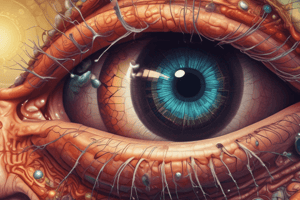Podcast
Questions and Answers
What is the epithelium layer of the pharyngeal tonsil?
What is the epithelium layer of the pharyngeal tonsil?
Where is the thymus dependent zone located in the lymph node?
Where is the thymus dependent zone located in the lymph node?
What is the function of type II pneumocytes?
What is the function of type II pneumocytes?
What type of sweat glands are found in the axilla?
What type of sweat glands are found in the axilla?
Signup and view all the answers
What is the type of epithelium in the taste buds?
What is the type of epithelium in the taste buds?
Signup and view all the answers
What is the shape of the liver acinus?
What is the shape of the liver acinus?
Signup and view all the answers
What type of muscles are found in the middle third of the esophagus?
What type of muscles are found in the middle third of the esophagus?
Signup and view all the answers
Where are the Peyer's patches found?
Where are the Peyer's patches found?
Signup and view all the answers
Which cells secrete growth hormone?
Which cells secrete growth hormone?
Signup and view all the answers
What is the epithelium layer of the prostatic part of the urethra?
What is the epithelium layer of the prostatic part of the urethra?
Signup and view all the answers
Which cells form the blood testis barrier?
Which cells form the blood testis barrier?
Signup and view all the answers
What is the outer epithelium of the Bowman's capsule?
What is the outer epithelium of the Bowman's capsule?
Signup and view all the answers
Which cells secrete melanocytes stimulating hormones?
Which cells secrete melanocytes stimulating hormones?
Signup and view all the answers
What is the capsule that surrounds the testis?
What is the capsule that surrounds the testis?
Signup and view all the answers
Which cells are classified as basophiles?
Which cells are classified as basophiles?
Signup and view all the answers
Which hormone rescues the corpus luteum from degeneration?
Which hormone rescues the corpus luteum from degeneration?
Signup and view all the answers
Study Notes
Lymphoid System
- Undifferentiated cells around the wall of capillaries are called Pericytes.
- Thymus dependent zones are present in the Paracortex of the lymph node.
Thymus
- The thymus is an organ that has both lymphoid and endocrine functions.
Tonsils
- The epithelium layer of the pharyngeal tonsil is Pseudostratified columnar ciliated epithelium.
- The Palatine tonsil is located in the Oropharynx.
Skin
- Langerhans cells are a type of macrophage found in the skin.
- Merkel cells are mechanoreceptors.
- Apocrine sweat glands are found in the axilla.
Respiratory System
- The layer under the epithelium of the trachea is Connective tissue.
- Type II pneumocytes secrete Surfactant.
- Type I pneumocytes are Simple cuboidal epithelium.
Blood Air Barrier
- The blood air barrier does not include the Cytoplasm and basement membrane of the Type II pneumocyte.
Tongue
- Filiform papillae do not contain taste buds.
- The epithelium layer of the dorsal surface of the tongue is Stratified squamous epithelium.
- Taste buds contain Neuro-epithelium.
Esophagus
- The middle third of the esophagus has both Skeletal and smooth muscle.
Intestine
- Enteroendocrine cells have an Infraneuclear nucleus.
- Paneth cells are found in Intestinal crypts.
- Caveolate cells are chemoreceptors in the small intestine.
- Peyer's patches are found in the Ileum.
Salivary Glands
- The major acini in the sublingual salivary gland are Mucous acini.
- Centroacinose cells belong to the Intercalary ducts.
- Intralobular ducts are secretory ducts.
Liver
- The liver acinus is Diamond-shaped.
- Von Kupffer cells stain with Trypan blue.
- Hepatocytes facing bile canaliculi have Short microvilli.
Clara Cells
- Clara cells have a characteristic dome-shaped apical end that projects into the lumen.
Adrenal Gland
- Aldosterone is secreted by Zona granulosa cells.
- Mesangial cells are located in the matrix between glomerular cells.
Pituitary Gland
- Somatotrophs secrete growth hormone.
Testis
- Sertoli cells form the blood-testis barrier.
Kidney
- Bile canaliculi are present between the rows of liver cells.
- Renal columns are located between renal pyramids.
- The outer epithelium of the Bowman's capsule is Simple squamous epithelium.
- The epithelium layer of the prostatic part of the urethra is Transitional epithelium.
Suprarenal Gland
- Spongiocytes belong to the Zona fasciculata.
- Pheochromocytes belong to the Suprarenal medulla.
Thyroid Gland
- Thyrotrophs are basophiles.
- Corticotrophs secrete ACTH.
- Pars intermedia secretes melanocytes stimulating hormones.
Pineal Body
- Pineal body cells secrete melatonin.
Reproductive System
- Parafollicular cells contain C-cells.
- The capsule surrounding the testis is the Tunica vaginalis.
- Spermatogenic and Sertoli cells form seminiferous tubules.
- The epithelium lining the epididymis is Pseudostratified columnar ciliated epithelium.
- Zona pelucida has a pinkish-red ring.
- Human Chorionic gonadotropin hormone rescues the corpus luteum from degeneration.
- Peg cells secrete fluids containing nutrients for the oocyte and promote capacitation.
Studying That Suits You
Use AI to generate personalized quizzes and flashcards to suit your learning preferences.
Related Documents
Description
This quiz assesses knowledge of the immune system, including the structure and function of various cells, tissues, and organs. Questions cover topics such as the thymus, lymph nodes, and types of immune cells.




